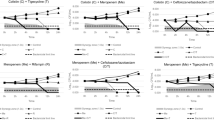Summary
Ciprofloxacin has a reduced activity against anaerobic pathogens. Therefore, a combination of ciprofloxacin with an antimicrobial agent active against anaerobes, such as metronidazole, seems to be interesting for the treatment of mixed aerobic/anaerobic infections. High metronidazole concentrations (10 mg/l or 40 mg/l) neither affected the bactericidal efficacy of ciprofloxacin on aerobic pathogens, such asEscherichia coli, Staphylococcus aureus, Pseudomonas aeruginosa andEnterococcus faecalis, nor on the anaerobic pathogensClostridium perfringens andClostridium difficile, as demonstrated by kill-kinetic curves. The same high concentrations, as well as lower therapeutically achievable concentrations (2 mg/l or 5 mg/l) of metronidazole in combination with ciprofloxacin were slightly more potent for the tested clostridia than ciprofloxacin or metronidazole alone.
Zusammenfassung
Ciprofloxacin weist gegenüber anaeroben Keimen eine herabgesetzte Aktivität auf. Insbesondere bei aeroben/anaeroben Mischinfektionen ist die Kombination von Ciprofloxacin mit einem Anaerobier-aktiven Therapeutikum wie z. B. Metronidazol wichtig. Wie sich anhand von Bakterizidiekinetiken zeigen ließ, wird weder die bakterizide Effizienz von Ciprofloxacin auf aerobe pathogene Keime, wie z. B.Escherichia coli, Staphylococcus aureus, Pseudomonas aeruginosa undEnterococcus faecalis, noch auf anaerobe Pathogene, wie z. B.Clostridium perfringens undClostridium difficile, durch hohe Metronidazolkonzentrationen (10 mg/l oder 40 mg/l) beeinträchtigt. Sowohl in hohen als auch in therapeutisch erreichbaren Metronidazolkonzentrationen erweist sich die Kombination mit Ciprofloxacin als aktiver auf die getesteten Clostridium-Stämme als die Substanzen alleine.
Similar content being viewed by others
References
Hooper, C. D., Weapon, J. S. The fluoroquinolones. Pharmacology, clinical uses, and toxicities in humans. Antimicrob. Agents Chemother. 28 (1985) 716–721.
National Committee for Clinical Laboratory Standards: Approved Standards. M7-A. Methods for dilution antimicrobial susceptibility tests for bacteria that grow aerobically. NCCLS 1985. Villanova.
Werk, R., Schneider, L. Inhibition of the bactericidal efficacy of ciprofloxacin in the presence of erythromycin, gentamicin and tetracycline. ZAC Zeitschrift für antimikrobielle und antineoplastische Chemotherapie 5 (1987) 25–29.
Crumplin, G. C., Kenwright, M., Hirst, T. Investigation into the mechanism of action of the antibacterial agent norfloxacin. J. Antimicrob. Chemother. 13 (1984) 9–23.
Bauernfeind, A., Höre, G.: Antagonism between 4-quinolones and clindamycin. Third European Congress of Clinical Microbiology. 1987. The Hague. Abstr. No. 340.
Zeiler, H. J. Evaluation of thein vitro bactericidal action of ciprofloxacin on cells ofEscherichia coli in the logarithmic and stationary phase of growth. Antimicrob. Agents Chemother. 28 (1985) 524–529.
Author information
Authors and Affiliations
Additional information
Supported by Bayer AG
Rights and permissions
About this article
Cite this article
Werk, R., Schneider, L. Ciprofloxacin in combination with metronidazole. Infection 16, 257–260 (1988). https://doi.org/10.1007/BF01650774
Issue Date:
DOI: https://doi.org/10.1007/BF01650774




